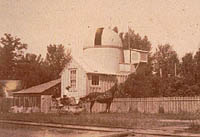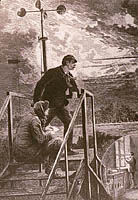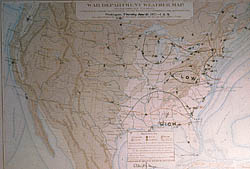 |
|
||||||||||||||||||||||||||||||||||||||
|
Follow Mark on Facebook for more stories |
||||||||||||||||||||||||||||||||||||||
|
Charles W. Friend: Nevada's Pioneer Weatherman Charles William Friend kept his feet on the ground but his eyes to the sky. His lifelong fascination with weather and astronomy benefited Nevada in many ways and his diligent efforts to establish a comprehensive climate record for the state were prescient. So it was only fitting that when the Nevada State Weather Service was established in 1887, the Carson City jeweler/scientist was selected as its first Director.
In his endeavor to compile a climatological record for Carson City, Friend took weather observations at 7 a.m., 2 p.m. and 9 p.m. and then divided the sum by three to determine the daily mean. His numerical measurements and detailed observations were regularly sent to the U.S. Army's Signal Service Office in Washington D.C. Testament to his attention to detail and commitment to scientific accuracy, in an 1885 report Friend noted the exact arrangement of his weather equipment installed at the observatory: "All the thermometers are placed in an instrument shelter, made of lattice blinds and projecting 20 inches from a large pane of glass in the north wall of the observatory, 12 inches from the window and at the height of the eye of the observer. The thermometers are placed on wooden bars one inch square, and while there is free access of air to the shelter, all radiant heat and rain or snow are effectually excluded." His meticulous attention to detail was critical to achieving accurate measurements, especially at a time when the standardization of observation times and proper use of weather instruments were woefully lacking.
During the 1870s, the U.S. Signal Service was doing its best to gather weather data nationally but it needed help, especially from the sparsely populated western states. In 1883 Nevada became the first state in the West to initiate and develop an active weather program when the Nevada State Legislature passed an Act "to procure meteorological reports for the State of Nevada, and to provide for the payment of the same." The Secretary of State contacted Charles Friend and purchased the two most recent years of his monthly weather reports for $300. Friend later donated to the State his complete collection of weather data and observations from 1880 to 1885. In an effort to help farmers and ranchers throughout the Silver State, the legislature established the Nevada State Weather Service (N.S.W.S.) in 1887. Professor Friend was appointed by Governor Charles Stevenson as Director of the new State Weather Service, the first such appointment by any state in the nation. The Director, according to the Act, would compile an annual report and receive a salary of $600 a year. Friend held that post until he died in 1907. During his tenure as Nevada's first meteorologist and climatologist, he worked with the U.S. Army's Signal Corp, the transcontinental railroad, and newspaper editors to enlist volunteer weather observers. Over the years the program succeeded in installing 37 weather stations around Nevada. It was a tough challenge for a small shopkeeper, but Charles Friend was up to the task. In his first annual report, Friend wrote: "Many difficulties beset the work of organizing the State Weather Service, and the outlook at first was not at all encouraging, but through determined effort and a deal of labor the service has assumed proportions and given promises of success far exceeding the most sanguine expectations of its friends and promoters." The data collected were frequently published in Nevada newspapers and used to better understand the state's climate and helped make accurate forecasts for the first time. In addition, the information regarding general rainfall patterns, growing seasons, and various microclimates proved highly valuable in the development of natural resources throughout the state.
Before he was hired as chief of the N.S.W.S., Friend measured and recorded climatological data at a nominal cost until the State, recognizing the importance of this information, made an appropriation to pay him for his research. In 1885 Nevada Governor Jewett Adams vetoed the bill which paid Friend $12.50 a month for "making and recording the meteorological changes at the State capital." According to an article in the Carson Daily Index, "…the Governor gave it as his opinion that the work of recording the climatic changes was of no benefit, and that the appropriation would be a waste of money." Editors at the Virginia City Territorial Enterprise shook their heads, noting that the governor's decision "…gave his enemies a chance to say some hard things against him, and left his friends no grounds upon which to base an argument in defense." Charles Friend quietly dismissed the political decision as shortsighted and continued his daily observations. Money has always been tight in the weather business. In January 1888, Director Friend alerted C.M. Fasset, the volunteer State Weather Observer for Reno, that he would soon begin receiving the daily weather forecasts from the Signal Service by telegraph from San Francisco. The vital information about storms approaching from the Pacific Coast was considered a boon to northern Nevada farmers. Better yet the forecast was free because the War Department picked up the tab for the telegrams. The only expense would be the erection of a flagpole at the intersection of Virginia Street and Commercial Row in Reno, and the purchase of weather flags that would warn citizens of approaching storms or cold waves. Indicative of the lack of state and federal funding available for the new weather network then developing in the United States, Mr. Fassat posted an article in the Reno Evening Gazette requesting citizens to pressure the County Commissioners to authorize the purchase of the flags and pole. The Reno forecasts were later posted on bulletin boards at the Post Office and at the University, while in Carson City signal flags were flown from the dome of the State Capitol. A plaque commemorating the memory and life's work of Charles Friend was dedicated in 1999 on Nevada Day at the site where his Carson City Observatory once stood. The modest monument to the Silver State's first weatherman, astronomer, and seismologist can be found in the grassy area just east of the Nevada State Library and Archives on Stewart Street. When Friend died on January 10, 1907, the borrowed telescope was returned to the federal government and the Nevada State Weather Service abandoned . Although the law authorizing the State Weather Service remained on the statute books until 1912, another Director was never appointed. By 1905 weather stations around the state had begun submitting their observations to the National Weather Service and the N.S.W.S. moved its station from Carson City to Reno.* Charles William Friend was a true visionary who wanted the best for Nevada and its citizens. When asked to explain why the State needed its own weather service, he wrote, "[It] would help bring prosperity to Nevada's agricultural concerns and weather stations around the State will enable the Signal Corps to accurately forecast the weather and give to every county the Government standard of temperature, rainfall, humidity, etc., which is useful information. It will educate the people in the physical and climatic condition of the country in which they live." Cheers to Charles Friend, Nevada's pioneer weatherman and preeminent weather warrior. *NOTE: After Charles Friend's death in 1907, no official weather readings were taken again in Carson City until the Sierra Pacific Power Company volunteered in 1923. These observations were taken until 1941 about two blocks northwest of the present-day Post Office near where the old Virginia & Truckee Railroad roundhouse sheds were located. In 1941 the weather equipment was moved to the roof of the State Highway Department at West 2nd and Carson Streets. It remained there until moved in 1965 to the roof of the new Department of Motor Vehicles building east of Stewart Street. In 1976 it was installed on the ground at the Dept. of Motor Vehicles until 1984, when it was moved to the Carson City Fire Dept. on Snyder Street in southeast Carson City, where it remains today. — Nevada Climate Summary, March 2003, Volume 20, Number 3 |
||||||||||||||||
|



